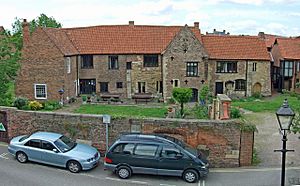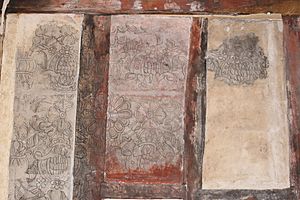Beverley Friary facts for kids
Quick facts for kids Beverley Friary |
|
|---|---|

Beverley Friary
|
|
| Location | Beverley |
| OS grid reference | TA038393 |
| Area | East Riding of Yorkshire, England |
|
Listed Building – Grade II*
|
|
| Designated | 1 March 1950 |
| Reference no. | 1084062 |
| Lua error in Module:Location_map at line 420: attempt to index field 'wikibase' (a nil value). | |
Beverley Friary, also called The Old Friary, is a group of buildings in Beverley, England. These buildings are very old and important. They are a Grade II* listed building. This means they are protected by law because of their special history. Since 1984, they have been used as a youth hostel. People think these buildings were once part of an old Dominican friary. Or, they might have been built on the friary's site using its old stones.
Contents
The Friary's Early Days
A Dominican friary was first set up in Beverley around c. 1240. Some records say it was even earlier, in 1210. The Dominicans were a group of monks. They were often called Blackfriars because of their dark robes.
The Archbishop of York, who was a powerful church leader, gave them land. This land was near Beverley Minster. Here, the Blackfriars built their first friary. It was probably made of wood at first. Later, when they had more money, they used stone.
Growing and Changing
As the community grew, the friary got bigger. In the early 1300s, they added a new building. This was built to the south-west of the cloister. A cloister is a covered walkway, usually in a monastery. This new building was for guests. The foundations of this guest building are still used today.
By the end of the 1300s, the friary was at its largest. But over the next 150 years, things slowly changed. The friary became less important. The buildings were used less and less.
The End of the Friary
In 1539, a big event happened. It was called the Dissolution of the Monasteries. This is when King Henry VIII closed down many monasteries and friaries in England. The remaining friars were forced to leave Beverley Friary that year. The property was badly damaged. Many buildings were pulled down. Their stones were used for other projects.
However, the guesthouse might have survived. It was not used for religious purposes. So, it might have been saved from being destroyed. Another idea is that the current buildings were built later. They might have used stones from other parts of the ruined friary.
What Happened After the Friary?
In 1544, the old guesthouse was sold. John Pope and Anthony Foster bought it. Later, it was sold again to the Wharton family. Then it went to the Earls of Yarborough. In 1826, Richard Whiteing bought it. His family owned part of the property until 1960.
The rest of the friary land was used for different things. In the 1800s, much of it was built over. This happened when the railway was built. It was part of the line between Hull and Bridlington.
Homes and Protection
During the 1800s, the guesthouse became three separate homes. These were numbers 7, 9, and 11 Friary Lane. They stayed as homes until the 1960s. Then, Armstrong Patents Co Ltd bought them. This company owned a nearby factory. In 1962, Armstrong's wanted to knock down the buildings.
But permission was refused. The houses were given a special "preservation order." This meant they had to be protected. Work to save them started in 1974.
Today, the buildings belong to East Riding of Yorkshire Council. They look after the buildings. The Beverley Friary Preservation Trust also helps. Since 1984, the YHA (England and Wales) has rented the buildings. They run a youth hostel there.
How it was Built
The buildings are made from a mix of brick and stone. They stand on the stone foundations of an older friary building. Some of the brickwork has a special pattern. This is called a diaper pattern. It uses bricks that are set deeper into the wall.
The roof is made of tiles. Inside, the walls are made with timber frames. These are wooden structures. During the restoration work, old wall paintings were found. These were on the plaster inside the westernmost building. They date from around the time the friary closed. One room has wooden panels. These panels are from the late 1500s or early 1600s.



